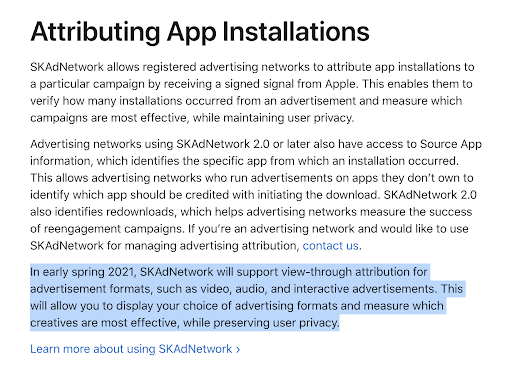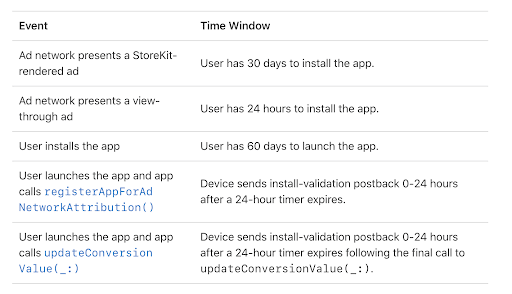As you all know, SKAdNetwork is Apple’s attribution framework that is about to offer Apple-validated attribution data for iOS 14. The new privacy guidelines and the de-facto deprecation of the IDFA will enter into effect with the next iOS version (14.5) rolling out in early spring 2021.
In the previous version of SKAdNetwork, there was very little information about the attribution logic that Apple will use and the exact ad types it will support.
I’m writing this article to shed some light (at least as much light as we have) on how SKAdNetwork attribution will soon work and the challenges it poses for mobile growth. Understanding these challenges will help you navigate these unchartered waters so you can make the right decisions, maximize growth and make your company happy.
In early February, Apple updated its User Privacy website with the following:

So we see that Apple mentioned adding support for view-through attribution for various advertisement formats. Time to dig into the SKAdNetworks docs and unpack this.
What’s changed with SKAdNetwork 2.2?
Well, “changed” is a problematic choice of words because there was very little information available before version 2.2 regarding supported ad types as well as the attribution logic. But now that Apple is gearing towards pushing SKAdNetwork as their complete attribution solution for iOS, they shared some more color.
Which ad types ad networks will support SKAdNetwork and are eligible for install verification?
According to Apple’s SKAdNetwork docs, we can learn that there will be two possible eligible ad types that ad networks will need to use if they want to receive any credit for the installs they drive via SKAdNetwork.
- Storekit Rendered Ads
These are not new in any way, but using Apple’s Storekit framework, these ads will render, as an impression, the actual full App Store Product page, allowing users to install the advertised app directly from the ad instead of redirecting them to the App Store app. The Storekit add will automatically record the ad impression.
- View-Through Ads
I found this name a bit confusing, but what it means is that any ad network will be able to use any ad format they want (video, image, playable, etc.) and report to SKAdNetwork that an ad impression has occurred by explicitly calling the SKAdNetwork API.
These two ad types and resulting impression types will be reported to SKAdNetwork with a new property called ‘fidelity’ to differentiate between them. Storekit ads will receive a Fidelity of 1, and view-through ads a Fidelity of 0.
Note that Apple created a differentiation between these two types of ads for a reason. I will get to that shortly.
How will the view-through attribution logic work?
Apple also provided a document that details the exact logic governing which ad will receive a credit for an install.
- SKAdNetwork will remember the last 15 impressions, and that’s it.
According to the official doc, SKAdNetwork will only remember the last 15 impressions for each user and each advertised app. If another impression occurs, let’s say a 16th one, the “oldest” impression will be deleted.
For an ad impression to qualify for install credit, it has to exist in this array of 15 impressions; if it’s out of the array, it has a 0% chance of receiving any credit. An impression can leave that array if it didn’t result in an install in the determined attribution window (see below) or if 15 more impressions took place after it.
- Fidelity matters, Storkit ads are more likely to get credit than view-through ones.
Although Apple seemed to be providing a ton of flexibility to ad networks with view-through ad units that they can customize in any way they see fit, they clearly state that Storekit ads will get preference within their attribution logic.”
- A) Attributions Affected by Fidelity Type and Recency
Remember that Fidelity property from before? SKAdNetwork will always credit the most recent ad impression with the highest Fidelity with an install. This means that even if a user viewed a view-through ad as the last impression, and even if that user clicked on the ad and installed the app, he considered a Storekit ad before that Storekit ad will receive the credit.
Here’s an example:
Let’s say User A viewed ad A, B, and then C. Both A and B were Storekit ads served on a particular network, and then C was a view-through ad served on a different network.
After the user viewed ad C, they clicked and installed the app.
Which ad will get the credit for the install? Ad B is the most recent ad impression with the highest Fidelity (of 1).
- B) Attributions Affected by attribution windows.
The benefit for a Storekit ad continues when examining the attribution windows. For an ad impression to get install credit, an install needs to occur within the attribution window (or it’ll leave the impressions array).
Take a look at the timeframes:

A Storekit ad has a 30-day time window to “wait” for an install. A view-through ad is much more short-lived, with only 24 hours to install before it’s ignored.
How this changes the incentive system in the ad network space
These two factors, the attribution logic as well as the attribution window, work together to dramatically increase the chances that if in a specific user journey a Storekit ad impression occurred, the Storekit impression will get the credit, even if the ad/s that affected the user decision to install were the view-through attribution.
This means that if an ad network wants to show its campaigns’ maximum success, it has a much better chance of doing so by serving Storekit ads than view-through ads.
Think not only about these ads getting inflated install figures by attributing to themselves installs that were a result of a view-through ad, but also the volume of organic installs that they’ll attribute (with the 30 days attribution window).
Mathematically speaking, campaigns using Storekit ads will have significantly more SKAdNetwork validated installs than view-through ad campaigns.
I expect that unless Apple changes the playing field, many ad networks will push towards Storekit ads.
Why is Apple creating a skewed attribution logic in favor of Storekit rendered ads or “app store page” ads?
Given that Apple is not providing any color on why they made these decisions, we’re left with our own thoughts.
My view is that Apple’s move with SKAdNetwork, iOS 14 privacy, ATT, and the IDFA is all about controlling the app user experience from start to finish. It’s about how users find apps (Search Ads in the App Store and other Apple Apps, Ad Networks) and even how these ads look and behave.
Apple probably believes that the Storekit ad provides the best user experience, with the most “what you see is what you get” vibe to it. We can imagine that Apple isn’t for “fake ads” and other behaviors they deem not Apple-like, so they want to reward ad networks that’ll provide that Storekit experience.
If ad networks are going to push for Storekit ads more than view-through, the App Store Page becomes extremely important, as it is the impression for those ads. The messaging on the app store page will have a considerable influence over these ads’ success. User Acquisition teams used to running ad creative optimization will need to think about their app store creative optimization even more.
If you need help with optimizing and testing your app store page, check out our ASO platform here.
Making the work of understanding what drives growth even more challenging
Lastly, suppose SKAdNetwork is the source of truth for which campaigns resulted in how many installs and the attribution logic are skewed. In that case, it’ll be tough to understand which campaigns and ads are contributing to incremental growth.
An extremely successful ad could show much fewer installs than it drove because of that new attribution logic. The wrong conclusion would be to stop running that ad.
So how would you be able to understand which campaigns and ads work best?
You have to look at the full picture. Only by examining aggregated data regarding impressions and installs, both paid and organic and both from SKAdNetwork/MMP and App Store Connect and Google Play Console you’ll be able to understand which campaigns/ads/activities are driving overall growth and double down.
For that, any mobile growth team, UA team, ASO team need to be thinking about the right infrastructure and ensure they have the “engine” to make these decisions. If you want to get a glimpse of what we’ve been building to enable teams to do just that — you can check out polarbeam.io and ask for a call.












